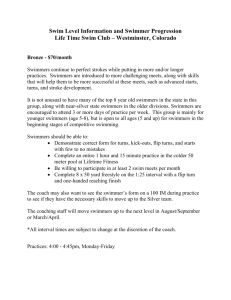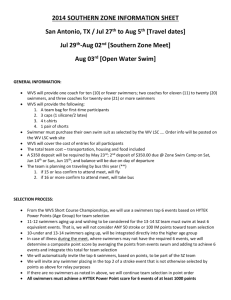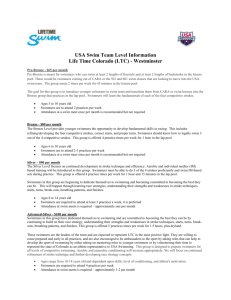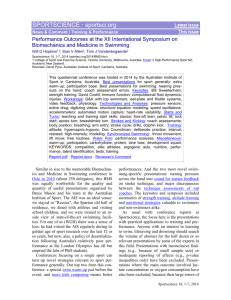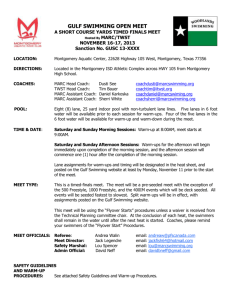Central Limit Theorem
advertisement
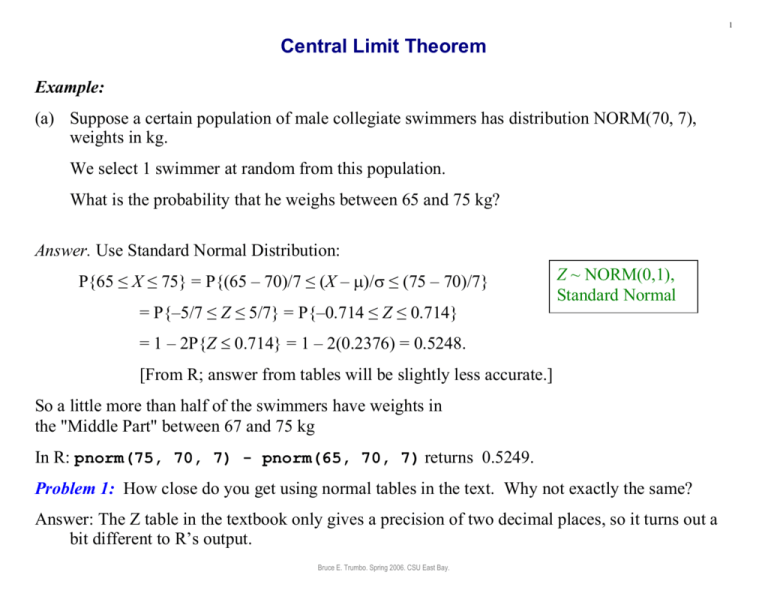
1
Central Limit Theorem
Example:
(a) Suppose a certain population of male collegiate swimmers has distribution NORM(70, 7),
weights in kg.
We select 1 swimmer at random from this population.
What is the probability that he weighs between 65 and 75 kg?
Answer. Use Standard Normal Distribution:
P{65 ≤ X ≤ 75} = P{(65 – 70)/7 ≤ (X – )/ ≤ (75 – 70)/7}
= P{–5/7 ≤ Z ≤ 5/7} = P{–0.714 ≤ Z ≤ 0.714}
Z ~ NORM(0,1),
Standard Normal
= 1 – 2P{Z 0.714} = 1 – 2(0.2376) = 0.5248.
[From R; answer from tables will be slightly less accurate.]
So a little more than half of the swimmers have weights in
the "Middle Part" between 67 and 75 kg
In R: pnorm(75, 70, 7) - pnorm(65, 70, 7) returns 0.5249.
Problem 1: How close do you get using normal tables in the text. Why not exactly the same?
Answer: The Z table in the textbook only gives a precision of two decimal places, so it turns out a
bit different to R’s output.
Bruce E. Trumbo. Spring 2006. CSU East Bay.
2
Note: Green lines at Area between them under this normal curve is 0.6826.
Problem 2: Verify probability in note using tables in text.
(b) Suppose a certain population of collegiate swimmers has distribution NORM(70, 7).
We select 9 swimmers at random from this population.
What is the probability that the sample mean weight is between 65 and 75 kg?
Answer. Use Statement B:
–
–
P{65 ≤ X ≤ 75} = P{(65 – 70)/(7/3) ≤ (X – )/(/n) ≤ (75 – 70)/(7/3)}
= P{–15/7 ≤ Z ≤ 15/7} = P{–2.143 ≤ Z ≤ 2.143} = 0.9679
[From R; answer from tables will be slightly less accurate.]
So almost all random samples of size n = 9 from this population will have
–
sample mean X between 65 and 75 kg.
Problem 3:
(i)
Verify this answer (as close as you can get) using normal tables in the text.
(ii) What is the probability that the mean of a sample of 5 swimmers lies between 65 and 75 kg?
(iii) What is the probability that the mean of a sample of 9 swimmers exceeds 72 kg?
Answer:
Bruce E. Trumbo. Spring 2006. CSU East Bay.
3
(ii) .8904
(iii) .1949.
(d) Suppose a certain population of collegiate swimmers has mean = 70 kg and = 7 kg.
However, we cannot be sure the population is normal in shape.
We select 9 swimmers at random from this population.
What is the probability that the sample mean weight is between 65 and 75 kg?
Answer. Use Statement C: The Central Limit Theorem.
The numerical solution is the same as in (b):
–
P{65 ≤ X ≤ 75} = 0.9679,
except this result is now an approximation.
The accuracy of the approximation depends on whether n is large enough for the
CLT-effect to be useful.
Problem 4: Same as (d), but with 12 swimmers, and the mean between 63 and 77.
Answer: .9994.
Bruce E. Trumbo. Spring 2006. CSU East Bay.
4
Statistical Application:
For data X1, X2, ..., Xn, a "95% Confidence Interval" for estimating is as follows:
–
X 1.96 /n.
–
This is based on the CLT and the idea that Z = (X – )/(/n) is approximately NORM(0, 1),
so that P{–1.96 < Z < 1.96} = 95%.
Problem 5: Verify this using normal tables in the text.
Problem 6: Suppose an appropriate sample of size 100 has sample mean 11.34 and standard
deviation 2.17. Find the 95% confidence interval for the population mean.
Answer: 11.34 1.96
2.17
100
(10.91,11.77).
Bruce E. Trumbo. Spring 2006. CSU East Bay.
